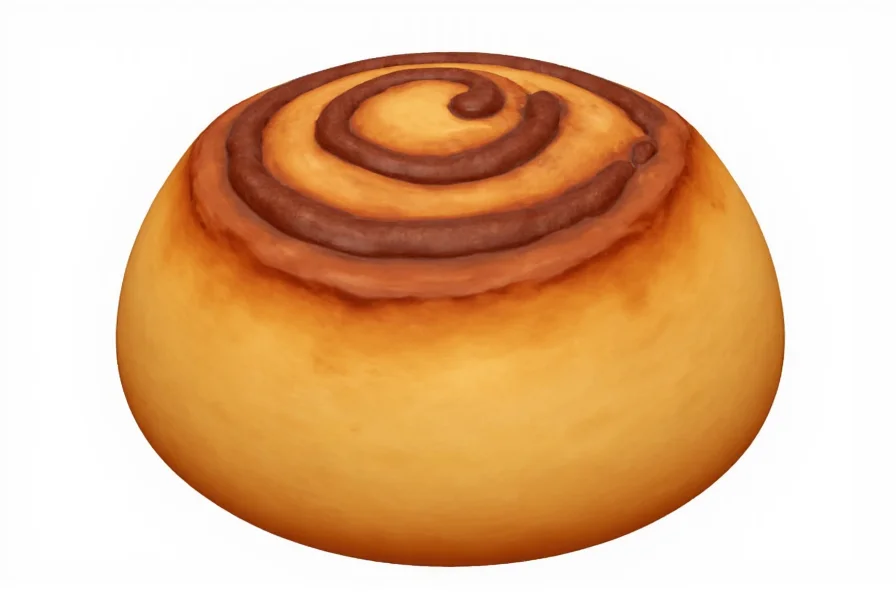Despite widespread belief, there's no dedicated cinnamon roll emoji available across major platforms. This common misconception stems from how the flatbread emoji (🫓) renders on certain devices, particularly Apple's iOS, where its swirled appearance resembles a cinnamon roll. Understanding this emoji reality helps avoid communication confusion when expressing baked goods digitally.
The Flatbread Emoji: Unintended Cinnamon Roll Substitute
Introduced in Unicode 13.0 (2020), the flatbread emoji (🫓) was designed to represent Middle Eastern flatbreads like pita or naan. However, Apple's distinctive rendering style—with its visible spiral pattern—promptly led users to repurpose it as a cinnamon roll symbol. This organic adoption demonstrates how emoji interpretation often evolves beyond official definitions.
| Platform | Appearance | Cinnamon Roll Likeness |
|---|---|---|
| Apple iOS | Swirled pattern | High (most commonly used) |
| Google Android | Plain flatbread | Low |
| Microsoft Windows | Minimal swirl | Moderate |
| Samsung | Subtle pattern | Moderate |
Why No Official Cinnamon Roll Emoji Exists
The Unicode Consortium, which governs emoji standards, prioritizes symbols with broad global relevance. While food emojis exist for culturally significant items, cinnamon rolls haven't met the threshold for universal adoption. The approval process requires demonstrating widespread usage potential across multiple languages and regions—a hurdle many dessert-specific emojis struggle to clear.
Food emoji proposals face rigorous evaluation based on:
- Cultural significance across multiple regions
- Differentiation from existing symbols
- Potential for misinterpretation
- Practical usage scenarios
Practical Usage Guidelines
When communicating about cinnamon rolls digitally, consider these best practices:
- Context is crucial: Pair 🫓 with descriptive text like "cinnamon roll breakfast" to prevent confusion
- Platform awareness: Remember Android users may see a plain flatbread rather than a swirled pastry
- Alternative combinations: Use 🥮 (moon cake) + 🍯 (honey pot) for a closer approximation on some platforms
- Avoid ambiguity: Don't rely solely on 🫓 in professional or critical communications
Common Misconceptions Clarified
Many social media posts incorrectly claim Apple created a special cinnamon roll emoji. In reality, all platforms use the same Unicode character (U+1FAB3), with only visual rendering differing. The perceived "cinnamon roll" appearance exists only in Apple's interpretation, not as a separate emoji code.
Similarly, petitions for an official cinnamon roll emoji often misunderstand the Unicode approval process. While over 3,500 emojis exist, the consortium receives hundreds of proposals annually, with only a select few meeting the stringent inclusion criteria.
Future Possibilities
The emoji landscape continues evolving. As global communication patterns shift, previously niche symbols may gain traction. Some designers have proposed modified flatbread variants specifically for pastry representation, though none have advanced through Unicode's formal submission process. Monitoring Unicode's annual release notes provides the most reliable way to track potential future additions.
Understanding the reality of the so-called "cinnamon roll emoji" prevents miscommunication while highlighting how digital language evolves organically. By using the flatbread emoji thoughtfully with appropriate context, you can effectively convey pastry-related messages despite the absence of an official symbol.
What is the actual Unicode name for the cinnamon roll emoji?
The symbol commonly used as a cinnamon roll emoji is officially named "Flatbread" (Unicode U+1FAB3). There is no officially recognized "cinnamon roll" emoji in the Unicode standard.
Why does the flatbread emoji look like a cinnamon roll on my iPhone?
Apple's iOS renders the flatbread emoji (🫓) with a distinctive spiral pattern that resembles a cinnamon roll's swirl. This design choice differs from other platforms like Android, which displays a plainer flatbread appearance without the prominent swirl.
How can I properly use the flatbread emoji as a cinnamon roll substitute?
For clear communication, always pair the flatbread emoji (🫓) with contextual text like "cinnamon roll" or "pastry". Be aware that Android users may interpret it as actual flatbread, so consider adding supplementary emojis like 🍯 (honey pot) or ☕ (coffee) to reinforce the pastry context.
Has there ever been an official proposal for a cinnamon roll emoji?
As of 2025, no formal proposal for a dedicated cinnamon roll emoji has progressed through the Unicode Consortium's submission process. While various online petitions exist, they haven't met the consortium's requirements for demonstrating sufficient global usage potential across multiple languages and regions.
Which emoji combinations best represent cinnamon rolls when 🫓 isn't available?
When the flatbread emoji isn't rendering as expected, try these combinations: 🥮 (moon cake) + 🍯 (honey pot), or 🥐 (croissant) + 🍫 (chocolate bar). Some users also employ 🌪️ (tornado) rotated sideways to suggest a swirl pattern, though this is less universally recognized.











 浙公网安备
33010002000092号
浙公网安备
33010002000092号 浙B2-20120091-4
浙B2-20120091-4